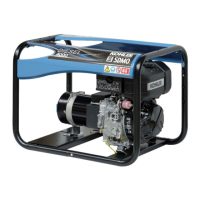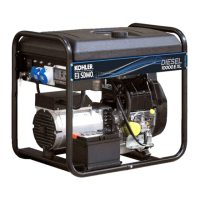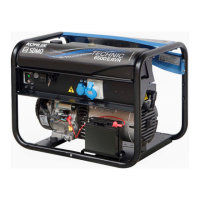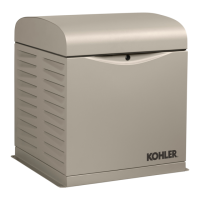7 Repairing minor faults
The checks before starting have been
performed.
The shutdown lever is not in the
"STOP" position.
Change the position of the shutdown lever.
The equipment to be used has not
been connected prior to starting.
Disconnect the equipment then try to start
the unit again.
Have the unit checked by one of our
agents*.
The oil level is correct.
The fuel level is correct.
Does not function normally
(noise, smoke, etc.)
Maintenance has been correctly
performed on the unit components.
Perform maintenance on the unit as per
the recommendations
Have the unit checked by one of our
agents*.
Does not supply electrical
current
Tripped circuit breaker(s).
Check the capacity of the unit and press
the circuit breakers.
The connected devices and their power
cords are not faulty.
Try with another item of equipment and
another power cord.
Have the unit checked by one of our
agents*.
*France: 0.806.800.107 (call charge)
7.1 Generator Smart Care
If the unit has been equipped with the "GS101-Generator Smart Care" option (A14),
it is necessary to change the batteries in the Bluetooth GSC101 box when the
warning is displayed in the Generator Smart Care application (approximately every
two years).
1. Use a small crosshead screwdriver to open the cover of the box,
2. Remove the used batteries and take them to a waste collection point so
that they can be recycled,
3. Fit two new AAA batteries, observing the polarity (+/-),
4. Close the unit cover and carefully tighten the screws.
8 Technical specifications
8.1 Operating conditions
The stated outputs of the units are obtained under the reference conditions outlined in ISO 8528-1(2005):
Total barometric pressure: 100 kPa - Ambient air temperature: 25°C (298 K) - Relative humidity: 30%.
The unit's output is reduced by approximately 4% for every additional 10°C and/or approximately 1% for every additional 100m in
altitude. Units can only operate while stationary.
8.2 Capacity of the generating set
Before connecting and operating the unit, calculate the electrical power required by the units to be used (in watts)*. To ensure
optimal operation, the total wattage of all equipment used at the same time must be:
- greater than 60% of the rated load for the unit (risk of insufficient load);
- less than the rated load for the unit during continuous operation (risk of overload).
If the unit is run under or over its rated load frequently or for long periods of time, it can start to wear very quickly. Damage caused
in this way will not be covered by the warranty.
*This load is usually indicated in the technical specifications or on the manufacturer's plate for the equipment. Some equipment requires a higher
load when starting. This minimum required power must not exceed the unit's maximum power.

